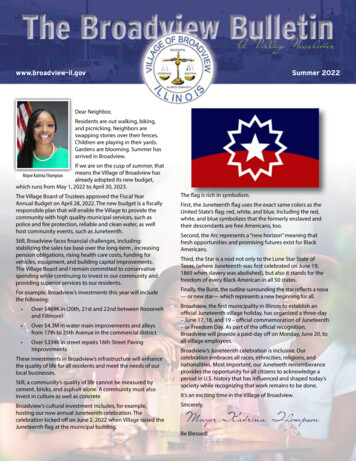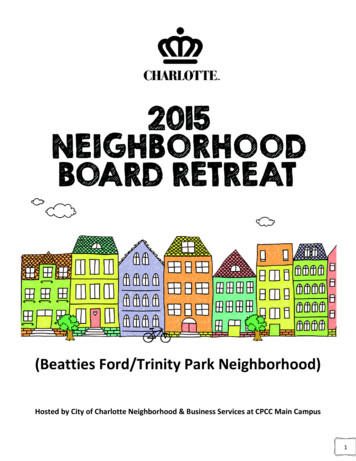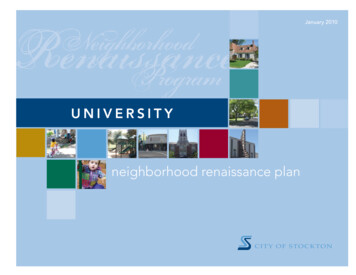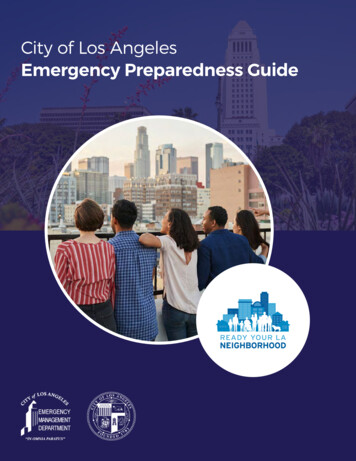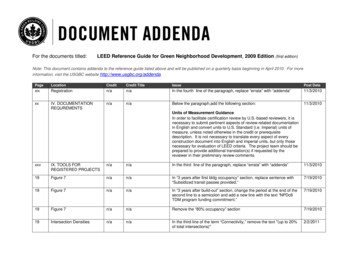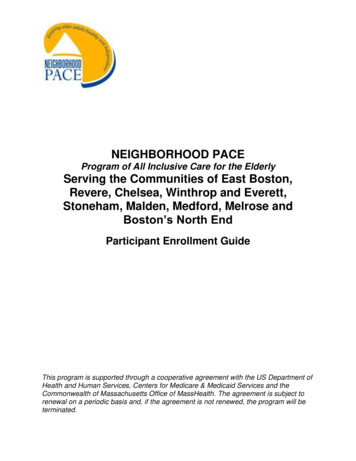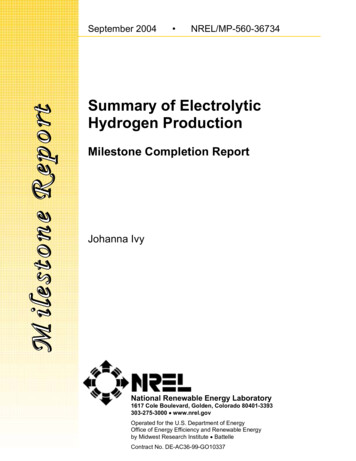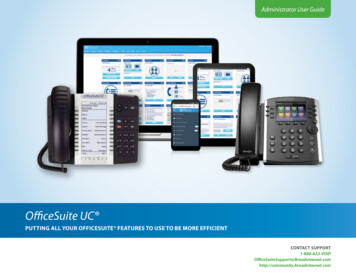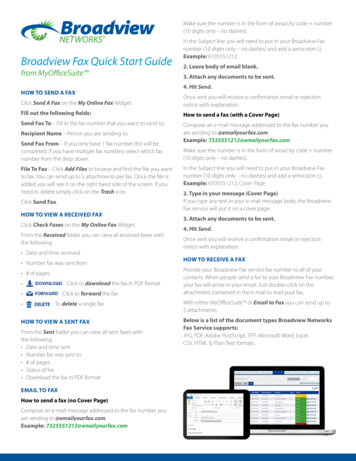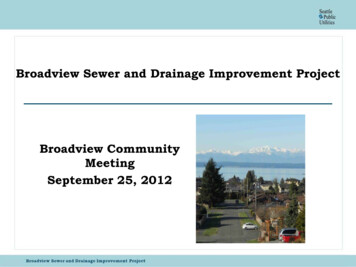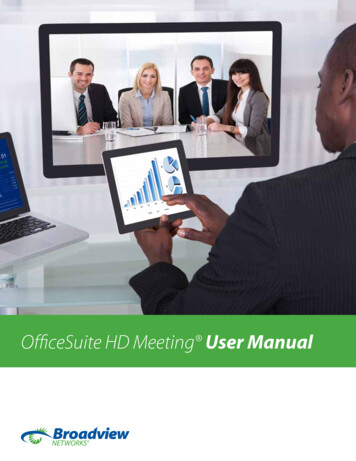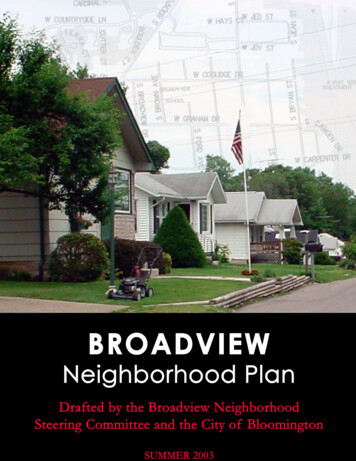
Transcription
We, the Broadview residents, desire to preserve qualities people value most about livingin a neighborhood for families. To provide adequate sidewalks, streets, lighting, and toraise our families in a clean, attractive community with ageless appeal.-The Broadview Neighborhood Vision Statement
Bloomington, IndianaThe BroadviewNeighborhood
AcknowledgementsWithout the generous donation of time and energy from manyindividuals, the Broadview Neighborhood Plan would not exist.The following citizens are recognized for the hours theyvolunteered to turn a neighborhood vision into a plan:THE BROADVIEW NEIGHBORHOOD STEERING COMMITTEEKaren Lewis, Chairperson, Broadview residentShirley Evans, Vice Chairperson, Broadview resident, BroadviewNeighborhood Association presidentLiz and Claude Sluder, Broadview residentsNancy Johnson, Broadview residentIda Bouvier, Broadview residentAlan and Jean Heuer, Broadview residentsJohn Payne, Broadview residentLarry Haywood, Broadview residentSue Wanzer, Monroe County Community School Corporationboard memberDavid Sabbagh, City Council member, District VCITY OF BLOOMINGTON MAYORJohn FernandezCITY OF BLOOMINGTON STAFFTom Micuda, AICP, Planning DirectorScott Robinson, Senior Long Range PlannerNate Nickel, Long Range PlannerFrank Nierzwicki, Long Range/Transportation ManagerSusie Johnson, Interim Executive DirectorVickie Provine, Program ManagerBob Woolford, Program ManagerNathan Schulte, Assistant Engineer (City of Bloomington Utilities)John Hewett, Neighborhood Compliance OfficerColleen M. Kearney, InternSpecial thanks to Principal Doug Waltz for allowing us to hold ourmeetings at the Broadview Elementary School.Broadview Elementary School,located in the heart of Broadview Neighborhood.
Statement of AcceptanceThe Broadview Steering Committee and The City of Bloomington hereby acknowledge theBroadview Neighborhood Plan. Through the City’s Neighborhood Planning Initiative and theneighborhood planning process, the Broadview Neighborhood Plan is recognized as adocument which will function as a tool to coordinate resources, open channels ofcommunication, and convey the prevailing interests of the neighborhood to the greatercommunity at large. We accept the purpose of this plan and will strive to work within theprescribed framework detailed within this plan now known officially as the BroadviewNeighborhood Plan.The Broadview Neighborhood PlanBROADVIEW STEERING COMMITTEE MEMBERS AND CITY OF BLOOMINGTON REPRESENTATIVES:Karen Lewis, Shirley Evans, Liz Sluder, Claude Sluder, Nancy Johnson, Ida Bouvier, AlanHeuer, Jean Heuer, John Payne, Larry Haywood, Sue Wanzer, David Sabbagh, JohnFernandez, Tom Micuda, and Susie Johnson
CONTENTSINTRODUCTIONNeighborhood Plans1Broadview’s Planning Process3How to Use the Neighborhood Plan6THE PLANThe Broadview Study Area9Goals & Objectives10Action Strategies Charts11APPENDICESA. Neighborhood Projects in Broadview18B. Existing Conditions & Observations19C. Broadview Zoning and Land Use22D. Broadview Demographics25E. Broadview Neighborhood Traffic Accident Data28F. Neighborhood Traffic Calming Techniques29G. Bloomington Urban Enterprise Zone30H. Bloomington Transit Bus Route Map31I. Glossary of Neighborhood Planning Terms32Broadview Neighborhood Plan Contents
INTRODUCTIONNeighborhood PlansBroadview’sPlanning ProcessHow to Use theNeighborhood Plan
I NTRODUCTIONNeighborhood Plan sNeighborhood planning is the process by which the City works withBloomington’s residents to envision the future of the neighborhood.The vitality of each of Bloomington’s neighborhoods depends oncareful consideration of each neighborhood’s unique identity andcharacter. The plan must strive to eliminate elements that erodecharacter and enhance elements that improve the quality of life forcurrent and future residents.Vibrant neighborhoods are essential to the overall health of thecommunity. Bloomington’s GPP recognizes the various assets itsneighborhoods bring to the city as a whole.Architecturalsignificance, pedestrian amenities, diversity, affordability, andproximity are several examples of resources that neighborhoodsmay possess. Preservation, enhancement, and revitalizationstrategies for such resources will ensure that Bloomington’sneighborhoods prosper.Through the planning process, neighborhood plans are developedfor Bloomington’s neighborhoods.This process allows aneighborhood to construct a clear vision of its needs and priorities,while maintaining consensus about what needs to beaccomplished. The strategies outlined within neighborhood plans,together with guidance from the GPP, will continue to makeBloomington an even better place to live.Neighborhood plans begin with the residents of a recognizedneighborhood association. A dedicated group of neighborhoodleaders and community representatives are brought together to setgoals, determine objectives, and establish action strategies topreserve, enhance, or revitalize neighborhood assets.Empowering residents to lead their neighbors in the planningprocess is the biggest and most rewarding aspect of neighborhoodplanning. Throughout this process neighborhood concerns areaddressed and coordination of efforts to solve problems isimproved by working together.Ultimately, a neighborhood plan is devised to resourcefully steerprivate investment and public services towards projects that aremost important to residents. It also encourages healthy interactionbetween citizens, business leaders, interest groups, andgovernment representatives. The final product of the neighborhoodplanning process is a living document composed of real projectsBroadview Neighborhood Plan Neighborhood Plans in Bloomington 1
that are timely and feasible. The resulting plans will create mutualtrust and bring together an association between citizens, businessand government where strategic alliances and friendships candevelop between all parties involved with a neighborhood. Theseplans will sustain neighborhood values and strengthen communityties, which are the fundamental keys to healthy vibrantneighborhoods. The City of Bloomington is eager to continuallywork with its neighborhood associations in developingNeighborhood Plans through the City’s Neighborhood PlanningInitiative.Neighborhood PlanningGrowth Policies PlanNeighborhood PlanningNeighborhood SelectionMonitor / Evaluate PlanNeighborhood PlanningProcessPlan ImplementationPlan Adoption2 Broadview Neighborhood Plan Neighborhood Plans in Bloomington
Broadview’s PlanningProcessThe recently adopted Growth Policies Plan (GPP) looks toneighborhood plans as an effective mechanism to aid in fulfillingthe guiding principle of Conserve Community Character. Theseplans should be designed to address housing, land uses, theprovision of public infrastructure and services, affordable housing,and infill development strategies. The Broadview Neighborhood isthe second neighborhood to participate in Bloomington’sNeighborhood Planning Initiative set forth in the GPP.In December of 2002, several City staff members met withBroadview residents and other interested parties to introduce theCity’s Neighborhood Planning Initiative. At this public meeting,City staff made a presentation which described the purpose of theinitiative, steps, time, and commitment involved with this planningprocess.Neighborhood residents, community leaders, and City staffparticipated in a strengths, weaknesses, opportunities, andthreats (SWOT) exercise in early January. This was the first stepin the neighborhood planning process, which required participantsto set out to investigate and survey the neighborhood.Participants were asked to identify and catalog neighborhoodfeatures which are either: a Strength - an attribute which contributes positively to thequality of life;a Weakness - an attribute which detracts from the qualityof life;an Opportunity - a condition that has the potential tobecome a strength;a Threat - a condition that has the potential to threaten thefuture of the neighborhood.The SWOT exercise provided an opportunity for everyone tofamiliarize themselves with various positive features anddrawbacks identified within the Broadview neighborhood. TheBroadview Neighborhood was split into small walk-able sub-areasto help facilitate the SWOT exercise. These sub-areas aredepicted in the figure shown on the next page. All of theparticipants were separated into two teams and assigned subareas to investigate and survey. Notebooks, maps, and cameraswere provided to each team so their observations could beproperly recorded.Broadview residents begin theneighborhood planning process.Broadview Neighborhood Plan Broadview’s Planning Process 3
After a couple of hours of field work, the teamsreconvened to discuss what they found. Aclearer picture of the strengths, weaknesses,opportunities, and threats within Broadviewbegan to materialize. The information collectedfrom this exercise resulted in a detailedinventory of attributes and conditions for eachsub-area within the neighborhood that was usedlater in the neighborhood planning process.The next step to the process was to form a coregroup of leaders, called a Steering Committee,who would guide the actual development of thegoals, objectives, and action strategies in theneighborhood plan. A Steering Committee waschosen from a broad range of individuals withdifferent levels of interest and involvement inBroadview. Individually they represent variousinterests, but as a group they are a unified voiceunique to Broadview. The Broadview Steering Committee was adedicated group of volunteers comprised of residents from all partsof the neighborhood, the neighborhood association president, aCity Council district representative, and a Monroe CountyCommunity School Corporation board member. Together they putforth the time and energy necessary to develop goals, objectives,and actions strategies – the vital components of neighborhoodplans.Over a period of several months the Steering Committee met on aregular basis to develop these components. Guided by City staff,the Steering Committee was put through a series of tasks. First,they had to prioritize the SWOT findings to help clarify theprevailing issues and concerns of Broadview (the results aresummarized in appendix B). Second, the Steering Committeewrote the vision statement for the Broadview Neighborhood. Third,the goals, objectives, and action strategies of the plan weredrafted. Fourth, the Steering Committee reviewed, revised, andapproved the final draft of the Broadview Neighborhood Plan.After the first two tasks were completed, the foundation of the planwas set. Ultimately, the prioritized SWOT and neighborhood visionstatement serve as a canvas for the plan to evolve upon. Withoutthese exercises, the Steering Committee would not have thenecessary background to draft representative goals, objectives,and action strategies for the Broadview Neighborhood.Drafting the goals, objectives, and action strategies of theneighborhood plan is one of the more difficult tasks of the process.4 Broadview Neighborhood Plan Broadview’s Planning ProcessThe six sections ofBroadview Neighborhoodas determined for theSWOT exercise.
During multiple meetings, the Steering Committee worked with Citystaff to develop these components of the Plan. The goals were thefirst component of the plan to develop. Once drafted, the goalsprovide a general target for the neighborhood to aim at for the nextthree to five years and cover a variety of issues. From here,objectives - provisions which have measurable elements that markprogress toward its intended goal - were proposed, discussed andagreed upon by the committee.Before the Steering Committee could proceed, neighborhood inputwas necessary to ensure that the drafted goals and objectiveswere representative of the neighborhood’s interests. An openhouse was held on April 10, 2003 where the public was invited toview and comment on the proposed goals and objectives. Thesesuggestions were later considered by the committee and thenecessary changes were made.From here, the Steering Committee had to devise action strategiesfor each objective. Action strategies direct programs, groups, andvarious activities to achieve the desired objectives developed forthe neighborhood. Like the goals and objectives, strategies wereproposed, discussed and agreed upon by the committee. Becausethese strategies often require various resources, a final review byCity departments and other identified resources was necessary toensure a mutual understanding between groups existed and therewas “buy in” from all parties involved.Once this phase of the process was completed, City staff compileda draft of the plan for the Steering Committee to review as their lasttask to accomplish. When approved, the final document wasformally presented to the neighborhood residents and generalpublic as the Broadview Neighborhood Plan.The action strategies provide plans for the near future of theneighborhood. Some of the strategies, for example enhancingalternative modes of transportation within the area, are alreadybeing carried out. Some strategies will be pursued within three tofive years. Periodically, the action strategies will be reviewed byCity staff and the Broadview Neighborhood to ensure the vitality ofthe plan and to make sure it continues to serve the needs of theneighborhood.Broadview Neighborhood Plan Broadview’s Planning Process 5
How to Use theNeighborhood PlanThe American Planning Association defines neighborhoods as“diverse, dynamic social and economic entities with uniquecharacteristics, which are recognized by residents of both theneighborhood and the community at large”.The best neighborhood plans will energize widespread communityrecognition of these unique characteristics. They will also build aframework that enables a neighborhood’s vision to gain support,not only at the neighborhood level, but throughout the entire City ofBloomington as well. The City of Bloomington is devoted todeveloping the best neighborhood plans because itsneighborhoods are the strategic building blocks of our greatcommunity.Through the neighborhood planning process, neighborhoods candevelop effective “living” neighborhood plans. This plan becomesa tool for the neighborhood and the greater community at large. Itwill provide a vision of the near future and a general education andawareness about the unique characteristics a neighborhoodpossesses. Additionally, it will begin to unify expectations sochanges can occur with a degree of precision and predictability.The plan will guide city departments, agencies, and commissions;as well as inform developers, landlords, architects, and engineers.It will continue to grow, evolve and adapt with the neighborhood.Trust, coordination, and openness are elements that are built intothe process. Together these help build great plans, but thechallenge remains to implement and make neighborhood planshappen.Left alone, great intentions, opportunities, andmotivations will be lost.Continuously working to implementstrategies of a neighborhood plan will ensure success.In the following pages, such strategies are detailed. An account ofBroadview’s planning process is included to provide a sense ofwhat neighborhood planning entails. The last section contains theappendices, which presents a variety of information related andunique to Broadview.The goals, objectives, and action strategies section containsorganizational charts of the essential components of the plan.These charts provide a useful road map to the who’s, what’s,where’s, when’s, and why’s of a desired neighborhood goal.6 Broadview Neighborhood Plan How to Use the Neighborhood Plan
Directing efforts and pursuing resources specified for an actionstrategy will contribute to achieving its corresponding objective.Subsequently, as action strategies are carried out, objectives willbe attained.As objectives are attained, goals will beaccomplished.Periodic meetings between the Neighborhood Association and theCity will allow for progress reports, evaluation, and modification ofthe action strategies. This plan is a “living tool” which will need tobe “fine tuned” from time to time as strategies are pursued withvarious degrees of satisfaction and participation.As timeproceeds, priorities may shift and focus may be lost. The future isuncertain, but a neighborhood’s vision is not!ACRONYMS USED IN THE NEIGHBORHOOD P LANBNABroadview Neighborhood AssociationGPPMonroe County Community SchoolCorporationGrowth Policies PlanSWOTStrength, Weakness, Opportunity, ThreatBESBroadview Elementary SchoolHANDHousing and Neighborhood DevelopmentBUEABloomington Urban Enterprise AssociationCBUCity of Bloomington UtilitiesBTBloomington TransitCONACouncil of Neighborhood AssociationsCDBGCommunity Development Block GrantsCIPCapital Improvement PlanBPDBloomington Police DepartmentMCCSCBroadview Neighborhood Plan How to Use the Neighborhood Plan 7
The BroadviewNeighborhoodPlanThe Broadview Study AreaGoals & ObjectivesAction Strategies Charts
THE PLANCity of BloomingtonBroadview StudyAreaLocated approximately one and a half miles fromBloomington’s downtown area and two miles fromthe Indiana University campus, Broadview is a219 acre neighborhood on the southwest side oftown.The CSX Rail Corridor borders theneighborhood’s eastern edge, Country Club Drivedefines its southern side, South Rockport Road isthe western border, and the intersection ofRogers and Cherokee makes up the northern tipof the neighborhood.Although an old and established area near thecity, the Broadview Neighborhood has onlyrecently been annexed into the City over the pastfew years in a three phase process. In Januaryof 2003, Broadview’s annexation by the City wascompleted.In and around Broadview there are critical sites which couldsubstantially impact the future of the neighborhood. Such sitesinclude the CSX Rail Corridor (proposed for redevelopment into anurban greenway and alternative transportation path), the IndianaEnterprise Center (formerly Thomson Consumer Electronics), theproposed site of a community and ary School (BES will soon close and anew school is under construction). Additionally,the Alternative Transportation and GreenwaysSystem Plan identifies projects along CountryClub Drive, Rogers Street, Rockport Road, andCherokee Drive. All of which can make for anexciting future for Broadview residents.The Broadview Neighborhood is characterized byits single family residences. Attractive greenspace with mature trees is common throughoutthe area.Broadview NeighborhoodBroadview Neighborhood Plan Broadview Study Area 9
Goals, Objectives & ActionStrategies for BroadviewThe key step of the neighborhood planning process is thedevelopment of goals, objectives and action strategies. Thesecomponents are the driving force behind each neighborhood plan.The neighborhood plan organizes the goals, objectives, and actionstrategies into Action Strategy Charts illustrated in the followingpages. These charts clearly state the action strategies andsummarize the logical resources and anticipated timeframeneeded for completion of each action.The charts are a useful tool to evaluate the progress ofimplementing the plans. Periodic meetings will be arrangedbetween the neighborhood association and the City to coordinateefforts and make any necessary adjustments to the prescribedstrategies. This will ensure that the objectives, goals, andultimately the vision become a reality.Successful plans are not measured by their individualaccomplishments, but rather by the cumulative results and synergycreated from executing various action strategies.Meetingneighborhood goals is what measures the success of a plan, butnot the success of a neighborhood. This can’t be measured.Broadview has chosen a pathway to its future. In the next sectionof the Plan this pathway is depicted by the goals, objectives, andaction strategies chosen for the Broadview Neighborhood.BROADVIEW GOALS:To improve public services thatwill create a safer environmentfor all ages and abilities;To promote the reuse ofBroadview Elementary School;To strengthen the BroadviewNeighborhood Association;To encourage pride inhomeownership;To improve our public image;To encourage new and existingsmall business;To educate Broadview residentsabout available servicesGoals -- The general statements ofpurpose or the long-term end toward whichprograms or activities are ultimatelydirected.Action Steps -- Direct programs, groups,or various activities to achieve theobjectives and goals drafted for theneighborhood.Objectives -- Provisions that havemeasurable elements to mark progresstowards the corresponding goal.Target Date -- Anticipated date orfrequency that an action strategy should beaccomplished.Resources -- Logical entities that shouldbe directly involved with the implementationof a specified action strategy.10 Broadview Neighborhood Plan Goals, Objectives, & Action Strategies
A CTION S TRATEGIESG OAL 1: T O IMPROVE PUBLIC SERVICES THAT WILL CREATE A SAFERENVIRONMENT FOR ALL AGES AND ABILITIESObjective A: Enhance alternative modes of transportation choices with improved access and safety.TargetDateResourcesImplement strategic plans identified in the Alternative Transportation and Greenways System Plan for1 projects detailed along Country Club Drive, Rogers Street, Rockport Road, Cherokee Drive, and the CSXcorridor.20032008Parks,Public Works,PlanningDevelop a regular schedule to monitor traffic volumes and speed along Rogers Street, Rockport Road,2 Country Club Drive, Ralston Drive, Coolidge Drive, and Graham Drive.2004Public WorksBroadview Neighborhood Association (BNA) to nominate representatives to attend the professional3 consultant workshops on the City’s Master Plan Study of the CSX Greenway Corridor.2003BNA, Parks,PlanningBNA to meet annually with Bloomington Transit (BT) to consider ways to encourage patronage of fixed4 routes and BT Access services.AnnuallyBNA, BTAction StepsObjective B: Continually strive to improve storm water drainage and other public facilities in the neighborhood.1Action StepsTargetDateResourcesHave the City of Bloomington Utilities (CBU) host a BNA meeting and give a presentation on availableservices, issues, and remedies relevant to the Broadview area.2004CBUBring City Departments together with BNA representatives to develop and update a Neighborhood2 Capital Improvement Plan (CIP) for public facilities. Annually report to BNA the status of projectsdetailed in the neighborhood CIP.The City will strive to utilize available Community Development Block Grant (CDBG) funds as well as3 pool various departmental resources for the neighborhood's high priority sewer extension, sidewalk, andstorm water drainage projects.20052006OngoingPublic Works,CBU,BNA,PlanningPublic Works,CBU,HANDBroadview Neighborhood Plan Action Strategies 11
A CTION S TRATEGIESGOAL 2: T O PROMOTE THE REUSE OF BROADVIEW ELEMENTARY SCHOOLObjective A: Broadview Neighborhood Association (BNA) to investigate and identify desirable opportunities to reuse theschool before it closes.TargetAction StepResourcesDate1BNA will send a petition and letter to the Monroe County Community School Corporation (MCCSC)stating the objectives of this goal and formally request representation in and/or notification of futureBroadview Elementary School (BES) facility use decisions.2003BNA, MCCSCObjective B: Recognize the important role that the BES functions as a neighborhood focal point and community center.1Action StepTargetDateResourcesBNA will initiate an Annual Broadview Picnic at BES to bring residents together to increase awareness ofthe BNA.AnnuallyBNAObjective C: Regularly identify programs and/or services that can utilize the BES to better serve Broadview residents.TargetDateAction StepsBNA to contact Bloomington Hospital to bring annual health fair/wellness education classes to theneighborhood.BNA to invite MCCSC to a special neighborhood meeting to identify types of adult education classes that2Broadview residents desire.BNA to request that MCCSC explore all possibilities, such as vocational education classes or joint ventures,3in order to bring day care services to CBNA,MCCSCObjective D: Retain the BES playground as a neighborhood park.Action StepBring MCSSC, the City’s Parks Department, BNA, and other potential groups together to explore grant1 mechanisms to retain the BES playground as a neighborhood park.TargetDateResources2004BNA, MCCSC,ParksBroadview Neighborhood Plan Action Strategies 12
GOAL 3: T O STRENGTHEN THE BROADVIEW NEIGHBORHOOD ASSOCIATIONObjective A: Increase attendance/participation at BNA meetings.Action Steps2Make sure all residents receive a flyer of BNA meetings with the topic, date, time, and place noted for allmeetings.Create a phone and e-mail contact list to facilitate BNA meeting reminders.3Create incentives for residents to attend BNA meetings (i.e. door NAObjective B: Develop a seasonal Broadview newsletter.Action Steps1 Secure a Broadview resident who will be in charge of the newsletter (e.g. “The Broad View”).2 Create a BNA website.TargetDateResourcesAnnuallyBNA2005BNA, CONATargetDateResourcesObjective C: Increase leadership skills of residents in Broadview.Action Steps1 Encourage enrollment in Citizen’s Academy and Connections Classes to develop leaders.AnnuallyOngoing2 Recruitment of two block captains a year.BNA, HANDBNAObjective D: Develop a neighborhood directory (services, interests, resident contact information, neighborhood watch, etc.).Action Step1 Neighborhood to apply for funding to develop this directory through a HAND Small and Simple Grant.TargetDateResources2004BNA, HANDBroadview Neighborhood Plan Action Strategies 13
A CTION S TRATEGIESGOAL 4: T O ENCOURAGE PRIDE IN HOMEOWNERSHIPObjective A: Preserve and maintain affordable single family homes through homeownership.Action StepsTargetDateResources1Host a program where Housing and Neighborhood Development (HAND) and other housing providerscan provide information on homeownership, maintenance, emergency assistance and other housingresources.2004BNA2HAND to send out periodic mailings on housing programs (e.g. Housing Resource Guide).20032008HANDObjective B: Annually identify and prioritize abandoned and/or neglected properties requiring the most immediate attention.Action StepsTargetDateResources1Arrange quarterly walks with the City’s Neighborhood Compliance Officer to identify and prioritizeproperties in need of attention.OngoingHAND, BNA2City to annually provide a list of neighborhood landlords to the BNA so contacts can be established andworking relationships can develop through regular invitations to attend BNA meetings/events anddelivery of the newsletter to area landlords.AnnuallyHAND, BNABroadview Neighborhood Plan Action Strategies 14
GOAL 5: T O IMPROVE OUR PUBLIC IMAGEObjective A: Continuously improve the general public’s perception of the Broadview Neighborhood.Action StepsPublicize local events in the neighborhood through editorials, public announcements, and newscoverage.Formally invite a different City (elected official/department personnel) guest speaker to host a “town hall”2 neighborhood meeting two times a year in order to inform and engage one another on the relevantissues of Broadview.Provide welcome baskets/kit for new neighbors. The kit should include the latest newsletter,3neighborhood plan, and any other pertinent information1TargetDateResourcesOngoingBNA2004 2008BNA2004BNA, HAND,Planning4BNA to develop a Neighborhood Watch Program2005BNA, BPD5Create an “Annual Volunteer Day” to help residents who need assistance in maintaining their homes andproperties2005BNA, HAND6BNA to apply for a HAND Neighborhood Cleanup Grant.AnnuallyBNA, HANDObjective B: Improve the aesthetics of the Broadview Neighborhood (through enhanced landscaping).Action StepsTargetDateResources1Attain HAND Grants to highlight Broadview’s gateway entrances (the intersections of Rogers andRockport, Country Club and Rockport, and Rogers and Country Club) with welcome signs, planters, orpublic art.2005Public Works,HAND, BNA2Utilize Monroe County’s/Purdue’s extension services on landscaping and gardeningOngoingBNA3Develop a spring plant exchange with donated or low cost landscaping materials (mulch, top soil, seeds,etc.)2005BNABroadview Neighborhood Plan Action Strategies 15
A CTION S TRATEGIESGOAL 6: T O ENCOURAGE NEW AND EXISTING SMALL BUSINESSObjective A: Identify opportunities within the neighborhood, which will attract a variety of locally owned small businesses.Action StepsTargetDateResources1Involve BNA as properties identified as Neighborhood Activity Centers (Rogers and Rockport, andRogers and Country Club) and Community Activity Centers (East of Country Club and Madison) willundergo discussions to be rezoned to allow for appropriately scaled commercial uses.2004Planning2Provide an information packet to BNA residents of Bloomington Urban Enterprise Association (BUEA)grants and other local incentives available for small businesses.2004BUEA3Notify BNA of any relevant zoning petition within the Broadview neighborhood.OngoingPlanning4Educate residents on allowable home occupations and conditional uses that could be supported in theneighborhood2004PlanningGOAL 7: T O EDUCATE BROADVIEW RESIDENTS ABOUT AVAILABLE SERVICESObjective A: Develop working relationships with the public sector and local service providers to identify the unique needs ofthe neighborhood and types of services available to Broadview residents.Action StepsTargetDateResources1Work with the Community and Family Resources Department (CFRD) to identify desirable resources andservice providers to periodically schedule special group presentations/speakers for NeighborhoodAss
A. Neighborhood Proje cts in Broadview 18 B. Existing Conditions & Observations 19 C. Broadview Zoning and Land Use 22 D. Broadview Demographics 25 E. Broadview Neigh borhood Traffic Accident Data 28 F. Neighborhood Traffic Calming Techniques 29 G. Bloomington Urban Enterprise Zone 30
